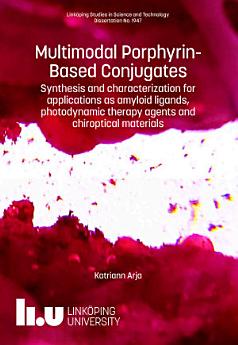Multimodal Porphyrin-Based Conjugates
About this ebook
Firstly, luminescent conjugated oligothiophenes (LCOs) that have extensively, and with great success, been utilized as fluorescent ligands for amyloid formations, have been conjugated to porphyrins to render oligothiophene porphyrin hybrids (OTPHs) comprising two optically active modalities. When applied as fluorescent amyloidophilic dyes for visualization of amyloid-? (A?), one of the pathological hallmarks in Alzheimer’s disease, an enhanced optical assignment of distinct aggregated forms of A? was afforded. Thus, properly functionalized OTPHs could give us more information about pathological processes underlying devastating disorders, such as Alzheimer’s disease. In addition, the OTPHs can be associated with synthetic peptides inducing peptide folding into certain three-dimensional helical structures giving rise to novel optically active materials.
Secondly, this thesis also embraces porphyrins’ potential as photosensitizers in photodynamic therapy to kill cancer cells. Grounded on the prerequisites for an optimal photosensitizer, we designed porphyrin-based conjugates equipped with common carbohydrates for improved cancer cell selectivity and with a fluorinated glucose derivative, 2-fluoro 2-deoxy glucose, for advantageous metabolism in cancer cells. Furthermore, incorporation of a radioisotopic fluorine-18 atom into the glycoporphyrins could give the means for diagnostic use of the conjugates in positron emission tomography (PET).
In order to tether together the above-mentioned molecular moieties in a controlled fashion, we developed a robust synthetic strategy for asymmetrical functionalization of porphyrin core. The method involves chlorosulfonation of this otherwise inert tetrapyrrolic structure, followed by alkynylation. Parallelly to amide coupling reactions, copper(I)-catalyzed alkyne azide cycloaddition is used for fast and high-yielding late-stage conjugations. Overall, this thesis demonstrates how combining different molecular moieties in synthetic organic chemistry yields novel molecules with combined and improved multimodal properties for biological and medicinal applications, guided by the design-by-function methodology.







